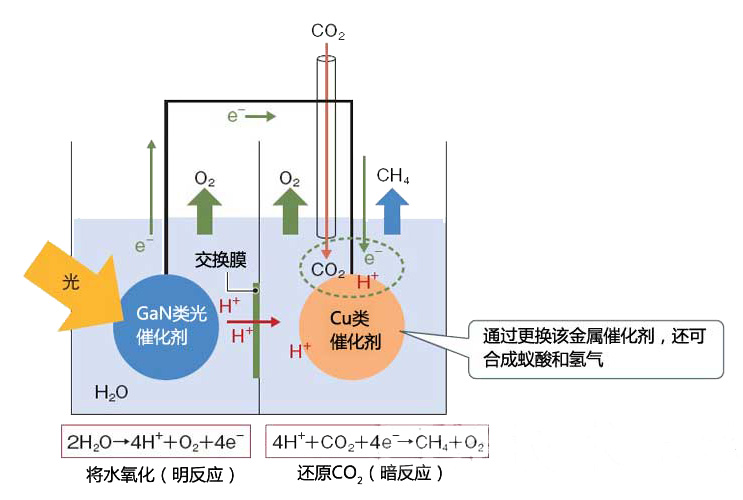 |
Photosynthesis system for methane synthesis developed by Panasonic
Panasonic has developed an artificial photosynthetic system that uses sunlight, water, and carbon dioxide (CO2) to synthesize methane (CH4) (Figure 1).
Both Panasonic and Toyota Central Research Institute have successfully synthesized formic acid (HCOOH) using an artificial photosynthetic system. Note 1). However, formic acid is limited to uses such as preservatives.
If methane can be synthesized, its use will expand. This is because, in addition to being used directly as a fuel gas, hydrogen can also be produced by reforming for a fuel cell. In response to the methane supply that has been confined to fossil fuels and biomass, Panasonic has created a road that can be used for industrial synthesis using endless raw materials.
This artificial photosynthetic system does not use a method that completely mimics the photosynthesis of plants, but utilizes inorganic materials. However, the two processes of water oxidation of "light reaction" and reduction of carbon dioxide "dark reaction" are used, which is the same as photosynthesis of plants.

Figure 1: Methane synthesis using the reverse process of fuel cell
An overview of Panasonic's synthetic photosynthesis system for methane synthesis is disclosed. Like the photosynthesis of plants, Panasonic divides it into a process that uses light to decompose water and a process that uses carbon dioxide to synthesize organic matter. The whole process is completely contrary to the principle of a fuel cell, which extracts hydrogen from methane and generates electricity when it is combined with oxygen.
After Panasonic developed a photosynthetic system for the synthesis of formic acid, it began to use gallium nitride (GaN) optical catalysts in its bright reaction. According to reports, GaN is suitable for increasing the energy of electrons to the reduction level of carbon dioxide. "In the past, titanium dioxide (TiO2) was used, but it was not effective enough to reduce carbon dioxide." (Songashi Takahashi, research fellow of the Environmental Materials Research Group of the Panasonic R&D headquarters' Advanced Technology Research Institute).
On the other hand, copper catalysts are used for the dark reaction metal catalysts. The biggest difference from the photosynthetic system when synthesizing formic acid lies in this metal catalyst. Indium phosphide (InP) materials are used in the synthesis of formic acid. "By changing the dark reaction metal catalyst, we can not only synthesize formic acid, methane and hydrogen, but also synthesize alcohol" (Fourth Panasonic Bridge).
The current problem is that the efficiency of methane synthesis is still very low. As of now, the synthetic efficiency defined by the ratio of formic acid fuel energy to input light energy is 2%, while methane is only 0.04%. Panasonic said, "To be practical, the efficiency of synthesis needs to be increased to more than 1%. We strive to achieve this goal." (Reporter: Nozawa Tetsuru, Nikkei Electronics)
Shower Faucets,Shower Faucet Set,Bathroom Shower Faucets,Single Handle Tub And Shower Faucet,Bathroom Shower Mixer Taps,Single handle bathtub faucet
JIAHAOJIA SANITARY WARE INDUSTRY CO., LTD. , https://www.gagalfaucet.com